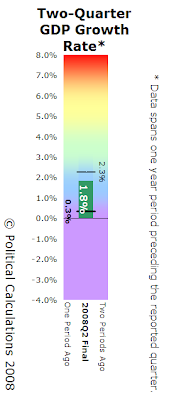Back when we originally created the temperature gauge bullet charts we use to visualized the U.S. GDP growth rate over time, we did so for a specific purpose: to better describe the health and trend of the U.S. economy. In doing that, we selected the visual depiction of the growth rate of GDP over two-quarter long periods as being particularly useful.
We developed this visualization approach as a way of dealing with the problems inherent in the common definition of a recession, in which a recession is considered to exist if you have two consecutive quarters of negative growth. What problems are those? Well, what if you have alternating positive and negative quarters of economic growth, as in the previous recession? Is there a way you could keep the common definition of a recession and be able to nail down when a recession might have begun even when you have that kind of situation?
We've since revised the basic design of the original bullet charts a couple of times, but now that we have a declared recession in the U.S., we thought it might be good to go back and see how well our bullet chart visualization did in potentially identifying when the recession began in the U.S.
We've presented two charts below side-by-side, which combine to cover U.S. GDP performance from the first quarter of 2007 through the fourth quarter of 2008. The first shows the data available as of when the inflation-adjusted GDP data for the second quarter of 2008 (2008-Q2) was first finalized, the second shows the inflation-adjusted GDP data through the fourth quarter of 2008 (2008-Q4), as provided by the advance release of this data on 30 January 2009:
In looking at the chart for 2008-Q2, at the data specifically covered by the "One Period Ago", we find that U.S. economic growth dipped down well into the "cold" zone of our bullet chart temperature gauge. That low value, deep in the purple zone consistent with recession-level economic performance in the U.S. since 1980, is the first indication that the NBER might find the two-quarter period spanning the fourth quarter of 2007 and the first quarter of 2008 as being when a recession would begin.
The NBER made that call in December 2008, finding the current recession to have begun in December 2007. Our visualization tool pegged 2007-Q4/2008-Q4 as being the most likely period in which a recession could have begun using a variation of the common definition of a recession back in April 2008, with the advance release of the first quarter of 2008's GDP data.
But that's no surprise to you, since you read Political Calculations to get ahead of the "official" information curve in the first place! Right Dr. Bernanke?
Labels: data visualization, gdp
Welcome to the blogosphere's toolchest! Here, unlike other blogs dedicated to analyzing current events, we create easy-to-use, simple tools to do the math related to them so you can get in on the action too! If you would like to learn more about these tools, or if you would like to contribute ideas to develop for this blog, please e-mail us at:
ironman at politicalcalculations
Thanks in advance!
Closing values for previous trading day.
This site is primarily powered by:
CSS Validation
RSS Site Feed
JavaScript
The tools on this site are built using JavaScript. If you would like to learn more, one of the best free resources on the web is available at W3Schools.com.

